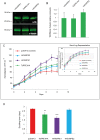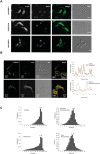Structure, kinetic characterization and subcellular localization of the two ribulose 5-phosphate epimerase isoenzymes from Trypanosoma cruzi
- PMID: 28207833
- PMCID: PMC5312968
- DOI: 10.1371/journal.pone.0172405
Structure, kinetic characterization and subcellular localization of the two ribulose 5-phosphate epimerase isoenzymes from Trypanosoma cruzi
Abstract
The enzyme of the pentose phosphate pathway (PPP) ribulose-5-phosphate-epimerase (RPE) is encoded by two genes present in the genome of Trypanosoma cruzi CL Brener clone: TcRPE1 and TcRPE2. Despite high sequence similarity at the amino acid residue level, the recombinant isoenzymes show a strikingly different kinetics. Whereas TcRPE2 follows a typical michaelian behavior, TcRPE1 shows a complex kinetic pattern, displaying a biphasic curve, suggesting the coexistence of -at least- two kinetically different molecular forms. Regarding the subcellular localization in epimastigotes, whereas TcRPE1 is a cytosolic enzyme, TcRPE2 is localized in glycosomes. To our knowledge, TcRPE2 is the first PPP isoenzyme that is exclusively localized in glycosomes. Over-expression of TcRPE1, but not of TcRPE2, significantly reduces the parasite doubling time in vitro, as compared with wild type epimastigotes. Both TcRPEs represent single domain proteins exhibiting the classical α/β TIM-barrel fold, as expected for enzymes with this activity. With regard to the architecture of the active site, all the important amino acid residues for catalysis -with the exception of M58- are also present in both TcRPEs models. The superimposition of the binding pocket of both isoenzyme models shows that they adopt essentially identical positions in the active site with a residue specific RMSD < 2Å, with the sole exception of S12, which displays a large deviation (residue specific RMSD: 11.07 Å). Studies on the quaternary arrangement of these isoenzymes reveal that both are present in a mixture of various oligomeric species made up of an even number of molecules, probably pointing to the dimer as their minimal functional unit. This multiplicity of oligomeric species has not been reported for any of the other RPEs studied so far and it might bear implications for the regulation of TcRPEs activity, although further investigation will be necessary to unravel the physiological significance of these structural findings.
Conflict of interest statement
Figures







Similar articles
-
Conversion of D-ribulose 5-phosphate to D-xylulose 5-phosphate: new insights from structural and biochemical studies on human RPE.FASEB J. 2011 Feb;25(2):497-504. doi: 10.1096/fj.10-171207. Epub 2010 Oct 5. FASEB J. 2011. PMID: 20923965 Free PMC article.
-
D-Ribulose 5-phosphate 3-epimerase: functional and structural relationships to members of the ribulose-phosphate binding (beta/alpha)8-barrel superfamily.Biochemistry. 2006 Feb 28;45(8):2493-503. doi: 10.1021/bi052474m. Biochemistry. 2006. PMID: 16489742
-
Catalysis and binding in L-ribulose-5-phosphate 4-epimerase: a comparison with L-fuculose-1-phosphate aldolase.Biochemistry. 2001 Dec 11;40(49):14772-80. doi: 10.1021/bi011252v. Biochemistry. 2001. PMID: 11732896
-
13C and deuterium isotope effects suggest an aldol cleavage mechanism for L-ribulose-5-phosphate 4-epimerase.Biochemistry. 2000 Apr 25;39(16):4808-20. doi: 10.1021/bi992894+. Biochemistry. 2000. PMID: 10769138
-
Structural basis for substrate specificity in phosphate binding (beta/alpha)8-barrels: D-allulose 6-phosphate 3-epimerase from Escherichia coli K-12.Biochemistry. 2008 Sep 9;47(36):9608-17. doi: 10.1021/bi800821v. Epub 2008 Aug 14. Biochemistry. 2008. PMID: 18700786 Free PMC article.
Cited by
-
Delineating transitions during the evolution of specialised peroxisomes: Glycosome formation in kinetoplastid and diplonemid protists.Front Cell Dev Biol. 2022 Sep 12;10:979269. doi: 10.3389/fcell.2022.979269. eCollection 2022. Front Cell Dev Biol. 2022. PMID: 36172271 Free PMC article.
-
Queueing theory model of pentose phosphate pathway.Sci Rep. 2022 Mar 17;12(1):4601. doi: 10.1038/s41598-022-08463-y. Sci Rep. 2022. PMID: 35301361 Free PMC article.
-
The Pentose Phosphate Pathway Dynamics in Cancer and Its Dependency on Intracellular pH.Metabolites. 2020 Jul 11;10(7):285. doi: 10.3390/metabo10070285. Metabolites. 2020. PMID: 32664469 Free PMC article. Review.
-
Enhanced Thermostability of D-Psicose 3-Epimerase from Clostridium bolteae through Rational Design and Engineering of New Disulfide Bridges.Int J Mol Sci. 2021 Sep 16;22(18):10007. doi: 10.3390/ijms221810007. Int J Mol Sci. 2021. PMID: 34576170 Free PMC article.
-
CSGID Solves Structures and Identifies Phenotypes for Five Enzymes in Toxoplasma gondii.Front Cell Infect Microbiol. 2018 Oct 5;8:352. doi: 10.3389/fcimb.2018.00352. eCollection 2018. Front Cell Infect Microbiol. 2018. PMID: 30345257 Free PMC article.
References
-
- Barrett MP. The Pentose Phosphate Pathway and Parasitic Protozoa. Parasitol Today. 1997;13(I):11–6. - PubMed
-
- Wood T. Purification and properties of d-ribulose-5-phosphate 3-epimerase from calf liver. BBA—Enzymol. 1979;570(2):352–62. - PubMed
-
- Nowitzki U, Wyrich R, Westhoff P, Henze K, Schnarrenberger C, Martin W. Cloning of the amphibolic Calvin cycle/OPPP enzyme d-ribulose-5-phosphate 3-epimerase (EC 5.1.3.1) from spinach chloroplasts: functional and evolutionary aspects. Plant Mol Biol. 1995;29(6):1279–91. - PubMed
-
- Bär J, Naumann M, Reuter R, Kopperschläger G. Improved purification of ribulose 5-phosphate 3-epimerase from Saccharomyces cerevisiae and characterization of the enzyme. Bioseparation. 1996;6(4):233–41. - PubMed
MeSH terms
Substances
LinkOut - more resources
Full Text Sources
Other Literature Sources
Research Materials

